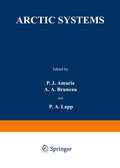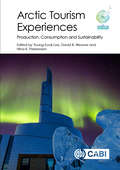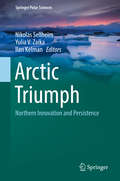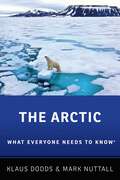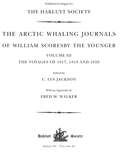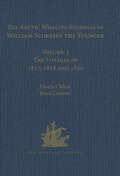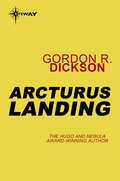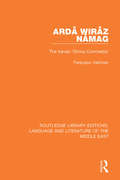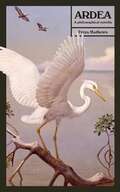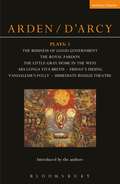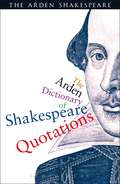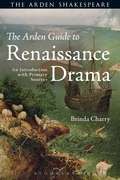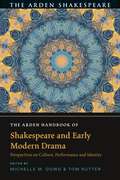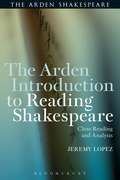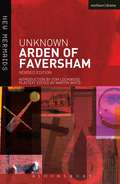- Table View
- List View
Arctic Systems (Nato Conference Series #2)
by P. AmariaFor the purpose of publication of these Proceedings, the original conference programme has been rearranged to provide a more logical sequence of presentation. The beginning sections give the inaugural speech and the six keynote addresses which were delivered at the opening plenary session. Following these are the working papers, published more or less in the same sequence in which they were presented in the original programme. The order of presentation does not necessarily emphasise the importance of any one aspect of the Arctic Systems over others. The final reports of the six working groups and their conclusions and recommendations are edited in such a manner as to present them in a standardised format for easy comprehension. The editors accept responsibility for any distortion inadvertently introduced in the summarising and editing processes. Later sections of the Proceedings give a background to the Conference organization and deliberations, and an independent critique of the meeting. The directors and those who attended the Conference were conscious of the debt of gratitude owed by them to the Conference chairmen, rapporteurs, authors of working papers, and many individuals for their contributions to the success of the meeting. We wish to thank them and it is a pleasure to record their names in these Proceedings. Inaugural Speaker Dr. J. Rennie Whitehead, Canada Banquet Guest Speaker Honourable Mr. T. Alex Hickman, Canada Keynote Addresses Mr. C. Bornemann, Denmark Dr. A.E. Collin, Canada Dr. R.E. Francois, U.S.A.
Arctic Tourism Experiences: Production, Consumption and Sustainability
by Isabelle Guissard Arild Røkenes Line Mathisen Sara Davoudi Claes Högström Bård Tronvoll Johan Edelheim Kjell Olsen Laura J Lawton Stein R Mathisen Hans Anton Stubberud Carsten Blom Ruud Ming-Feng Huang Chuanzhong Tang Raija Komppula Beate Bursta Peter Fischer Giovanna Bertella Sølvi Lyngnes Carl Cater Margaret E. Johnston Elsa De Souza R. Harvey Lemelin Sergey Ilkevich Per Strömberg Peter Haugseth Urban WråkbergAn exploration of Arctic tourism, focusing on tourist experiences and industry provision of those experiences; this is the first compilation to concentrate on the fundamental essence of the Arctic as being a geographical periphery, but also an experiential core that offers peak tourism experiences. Part 1 investigates the depth and dimensions of tourist experiences in the Arctic. Chapters examine the essence of diverse peak experiences and delve into the factors that give rise to these experiences. Part 2 considers the links between these core experiences and the tourism industry that seeks to sustain itself by facilitating such satisfying outcomes.
Arctic Triumph: Northern Innovation and Persistence (Springer Polar Sciences)
by Nikolas Sellheim Yulia V. Zaika Ilan KelmanThis book approaches the challenges the Arctic has faced and is facing through a lens of opportunity. Through pinpointed examples from and dealing with the Circumpolar North, the Arctic is depicted as a region where people and peoples have managed to endure despite significant challenges at hand. This book treats the ‘Arctic of disasters’ as an innovated narrative and asks how the ‘disaster pieces’ of Arctic discourse interact with the ability of Arctic peoples, communities and regions to counter disaster, adversity, and doom. While not neglecting the scientifically established challenges associated with climate change and other (potentially) disastrous processes in the north, this book calls for a paradigm shift from perceiving the ‘Arctic of disasters’ to an ‘Arctic of triumph’. Particular attention is therefore given to selected Arctic achievements that underline ‘triumphant’ developments in the north, even when Arctic triumph and disaster intersect.
Arctic Underwater Operations: Medical and Operational Aspects of Diving Activities in Arctic Conditions
by LouisReyOpening Speech of the ICEDIVE 84 Conference by His Royal Highness Prince Bertil of Sweden I am very pleased to be invited to open the International Conference ICEDIVE 84, dealing with medical and technical problems of diving and related underwater activities in arctic conditions. Until recent times, the arctic was considered astrange and remote area of minor importance. However, in a world with diminishing natural resources, arctic areas have become a region of global importance because of their enormous resources and strategie position. Certain experts believe that more than 50% of oil reserves are "sleeping" in these northern areas which are cold, harsh and hostile to man. Operations in arctic areas are extremely difficult, expensive, and demand high levels of technical, scientific and physiological achievement. One should recall for example, that Alaskan oil investment onIy became economically viable after the 1973-1974 price explosion. Recent political/military troubles in the Gulf have increased interest in the development of polar resources. This conference is unique as it is the first time that medical and technical specialists interested in the problem of diving in arctic conditions have met in an international forum. Development of the arctic resources is a matter of international urgency, and it pleases me that scientists from the USA, Canada, the USSR, Australia and Europe have gathered here in Stockholm to present their experience and to discuss problems in this field.
ARCTIC WENK C: What Everyone Needs to Know® (What Everyone Needs To Know®)
by Klaus Dodds Mark NuttallConversations defining the Arctic region often provoke debate and controversy -- for scientists, this lies in the imprecise and imaginary line known as the Arctic Circle; for countries like Canada, Russia, the United States, and Denmark, such discussions are based in competition for land and resources; for indigenous communities, those discussions are also rooted in issues of rights. These shifting lines are only made murkier by the threat of global climate change. In the Arctic Ocean, the consequences of Earth's warming trend are most immediately observable in the multi-year and perennial ice that has begun to melt, which threatens ice-dependent microorganisms and, eventually, will disrupt all of Arctic life and raise sea levels globally. In The Arctic: What Everyone Needs to Know®, Klaus Dodds and Mark Nuttall offer concise answers to the myriad questions that arise when looking at the circumpolar North. They focus on its peoples, politics, environment, resource development, and conservation to provide critical information about how changes there can, and will, affect our entire globe and all of its inhabitants. Dodds and Nuttall explore how the Arctic's importance has grown over time, the region's role during the Cold War, indigenous communities and their history, and the past and future of the Arctic's governance, among other crucial topics.
The Arctic Whaling Journals of William Scoresby the Younger: Volume III: The voyages of 1817, 1818 and 1820 (Hakluyt Society, Third Series)
by William ScoresbyThis is the third and final volume in the set of William Scoresby's journals. It contains the unpublished accounts of his three voyages 1817, 1818 and 1820. During the years of the voyages in this volume Scoresby's life changed profoundly. An unsuccessful hunt for whales in 1817 led to a break with the Whitby shipowners, and command of the Fame in 1818 in partnership with his father. The partnership was a brief one, and at the end of 1818 Scoresby broke with his father and moved to Liverpool, finding new partners, completing the writing of An Account of the Arctic Regions and watching the construction of his new ship, the Baffin. Meanwhile he suffered a severe financial loss and made a profound religious commitment. After his first summer ashore for many years in 1819, he brought back to Liverpool in 1820 a 'full ship' of seventeen whales, despite being faced by mutineers in the crew who earlier had been involved in piracy in the Caribbean and, apparently, hoped to seize the Baffin 'and convey her and her valuable cargo to a foreign country'. In each of the journals, Scoresby wrote detailed descriptions of his landings: on Jan Mayen in 1817, western Spitsbergen in 1818, and the Langanes peninsula in northeast Iceland in 1820. The 1817 voyage, when Scoresby and others found the Greenland Sea relatively free of ice, involved him in the renewed British interest in arctic maritime exploration after the Napoleonic Wars. The Introduction to this volume contains a major reappraisal of Scoresby's role, especially in regard to his alleged mistreatment by John Barrow, Second Secretary of the Admiralty. The volume also contains an appendix by Fred M. Walker on the building of wooden whaleships such as the Baffin that were capable of routine ice navigation under sail as far north as 80°N, based on Scoresby's account, as Owners' Representative, at the beginning of the 1820 journal.
The Arctic Whaling Journals of William Scoresby the Younger: Volume III: The voyages of 1817, 1818 and 1820 (Hakluyt Society, Third Series)
by William ScoresbyThis is the third and final volume in the set of William Scoresby's journals. It contains the unpublished accounts of his three voyages 1817, 1818 and 1820. During the years of the voyages in this volume Scoresby's life changed profoundly. An unsuccessful hunt for whales in 1817 led to a break with the Whitby shipowners, and command of the Fame in 1818 in partnership with his father. The partnership was a brief one, and at the end of 1818 Scoresby broke with his father and moved to Liverpool, finding new partners, completing the writing of An Account of the Arctic Regions and watching the construction of his new ship, the Baffin. Meanwhile he suffered a severe financial loss and made a profound religious commitment. After his first summer ashore for many years in 1819, he brought back to Liverpool in 1820 a 'full ship' of seventeen whales, despite being faced by mutineers in the crew who earlier had been involved in piracy in the Caribbean and, apparently, hoped to seize the Baffin 'and convey her and her valuable cargo to a foreign country'. In each of the journals, Scoresby wrote detailed descriptions of his landings: on Jan Mayen in 1817, western Spitsbergen in 1818, and the Langanes peninsula in northeast Iceland in 1820. The 1817 voyage, when Scoresby and others found the Greenland Sea relatively free of ice, involved him in the renewed British interest in arctic maritime exploration after the Napoleonic Wars. The Introduction to this volume contains a major reappraisal of Scoresby's role, especially in regard to his alleged mistreatment by John Barrow, Second Secretary of the Admiralty. The volume also contains an appendix by Fred M. Walker on the building of wooden whaleships such as the Baffin that were capable of routine ice navigation under sail as far north as 80°N, based on Scoresby's account, as Owners' Representative, at the beginning of the 1820 journal.
The Arctic Whaling Journals of William Scoresby the Younger / Volume I / The Voyages of 1811, 1812 and 1813 (Hakluyt Society, Third Series)
by William ScoresbyWilliam Scoresby (1789-1857) made his first voyage in the whaler Resolution from Whitby to the Greenland Sea, west of Spitsbergen, in 1800. Three years later he was formally apprenticed to his father and another three years saw him promoted to chief officer. On 5 October 1810, his twenty-first birthday, ’the earliest at which, by reason of age, I could legally hold a command’, his father moved to Greenock and another ship, relinquishing the Resolution to his son. Another ten years would see the publication of what has been described as ’one of the most remarkable books in the English language’, his two-volume An Account of the Arctic Regions, with a History and Description of the Northern Whale-Fishery (1820). Even before he took command of the Resolution, two developments had occurred that, when combined with his seamanship and whaling skill, were to make that book ’the foundation stone of Arctic science’ and cause the journals of his annual voyages to be remarkable accounts in their own right. First, Scoresby had studied, during two brief winters at the University of Edinburgh. Teachers such as John Playfair and Robert Jameson had made him aware of the scientific importance of his arctic experience. Together with Sir Joseph Banks, the president of the Royal Society, they encouraged him to observe, experiment and record, and provided opportunities for his data to be published. Secondly, this encouragement, and the study habits he developed at Edinburgh, led Scoresby to expand the logs of his arctic voyages into lengthy journals that contained scientific records and social and religious comment as well as detailed descriptions of navigation and whaling.
The Arctic Whaling Journals of William Scoresby the Younger / Volume I / The Voyages of 1811, 1812 and 1813 (Hakluyt Society, Third Series)
by William ScoresbyWilliam Scoresby (1789-1857) made his first voyage in the whaler Resolution from Whitby to the Greenland Sea, west of Spitsbergen, in 1800. Three years later he was formally apprenticed to his father and another three years saw him promoted to chief officer. On 5 October 1810, his twenty-first birthday, ’the earliest at which, by reason of age, I could legally hold a command’, his father moved to Greenock and another ship, relinquishing the Resolution to his son. Another ten years would see the publication of what has been described as ’one of the most remarkable books in the English language’, his two-volume An Account of the Arctic Regions, with a History and Description of the Northern Whale-Fishery (1820). Even before he took command of the Resolution, two developments had occurred that, when combined with his seamanship and whaling skill, were to make that book ’the foundation stone of Arctic science’ and cause the journals of his annual voyages to be remarkable accounts in their own right. First, Scoresby had studied, during two brief winters at the University of Edinburgh. Teachers such as John Playfair and Robert Jameson had made him aware of the scientific importance of his arctic experience. Together with Sir Joseph Banks, the president of the Royal Society, they encouraged him to observe, experiment and record, and provided opportunities for his data to be published. Secondly, this encouragement, and the study habits he developed at Edinburgh, led Scoresby to expand the logs of his arctic voyages into lengthy journals that contained scientific records and social and religious comment as well as detailed descriptions of navigation and whaling.
Arcturus Landing
by Gordon R DicksonJohnny Parent was driven by a furious anger - anger against the cocky aliens from outer space and anger against the company which had hired him to build the space drive which would lift the quarantine against Earth.It was a tough problem - made tougher by the company's double-dealing. And Johnny didn't relish the thought of cracking it with a whip on his back and a knife at his throat.Then he stumbled upon an eccentric young playboy, his pretty but ambitious secretary and weird little alien with colossal strength. Together they plotted the piratical flight into space which would earn Earth its due place in the Universe.But they had to hurry - because the company's strong men were right behind them - and the sola time clock was running out!
Ardā Wirāz Nāmag: The Iranian 'Divina Commedia' (Routledge Library Editions: Language & Literature of the Middle East)
by Fereydun VahmanArdā Wirāz Nāmag or the Book of the Righteous Wirāz is an outstanding example of Iranian apocalyptic literature. It is in the Middle Persian (Pahlavi) language and was written probably during the later period of the Sasanian dynasty (AD 226-650). The Zoroastrian priests chose a man called Wirāz, the most righteous among them, to go to the spiritual realm to discover the truth of the religion. This book, first published in 1986, contains the observations of Wirāz’ divine journey and his description of heaven and hell. The basic MS. is K20 (Royal Library of Copenhagen) which is carefully compared with other MSS. The MS. is printed in facsimile, followed by transliteration and transcription following the MS. closely line by line. A full translation is given, and a commentary is included together with a glossary, bibliography and index.
Ardā Wirāz Nāmag: The Iranian 'Divina Commedia' (Routledge Library Editions: Language & Literature of the Middle East)
by Fereydun VahmanArdā Wirāz Nāmag or the Book of the Righteous Wirāz is an outstanding example of Iranian apocalyptic literature. It is in the Middle Persian (Pahlavi) language and was written probably during the later period of the Sasanian dynasty (AD 226-650). The Zoroastrian priests chose a man called Wirāz, the most righteous among them, to go to the spiritual realm to discover the truth of the religion. This book, first published in 1986, contains the observations of Wirāz’ divine journey and his description of heaven and hell. The basic MS. is K20 (Royal Library of Copenhagen) which is carefully compared with other MSS. The MS. is printed in facsimile, followed by transliteration and transcription following the MS. closely line by line. A full translation is given, and a commentary is included together with a glossary, bibliography and index.
Ardea: A Philosophical Novella
by Freya MathewsWhat is soul? Can it be forfeited? Can it be traded away? If it can, what would ensue? What consequences would follow from loss of soul — for the individual, for society, for the earth? In the early nineteenth century, Goethe’s hero, Faust, became a defining archetype of modernity, a harbinger of the existential possibilities and moral complexities of the modern condition. But today the dire consequences of the Faustian pact with the devil are becoming alarmingly visible. In light of this, how would Goethe’s arguably flawed drama play out in a 21st-century century setting? Would a contemporary Faust sign up to a demonic deal? Indeed what, in the wake of two hundred years of social and economic development, would be left for the devil to offer him? A contemporary Faust would already possess everything the original Faust in his ascetic cloister lacked — affluence and mobility; celebrity and worldly influence; access to information; religious choice; sexual freedom and the availability of women — though women, it must be noted, currently also partake of that same freedom. The only thing a present-day Faust would lack would be his soul. Would he miss it? Does soul even exist? If it does, it would of course be the one thing the devil could not bestow. So from what or whom could Faust retrieve it? What, in a word, would a contemporary Faust most deeply desire? In pursuit of these questions, Ardea engages a familiar but possibly faulty archetype, that of Faust, with an unfamiliar one, that of the white heron, borrowed from a short story of the same name by nineteenth-century American author, Sarah Orne Jewett. In Jewett’s tale, a soul-pact of an entirely different kind from that entered into by Faust is proposed. It is a pact with the wild, a pledge of fealty, of non-forfeiture, that promises to redraw the violent psycho-sexual and psycho-spiritual patterns that have underpinned modernity. How would a present-day heir to the Faustian tradition, ingrained with the habit of entitlement but also burdened with the consequences of the old pact, respond to the new proposition?
Arden / D'Arcy Plays: 1 (Contemporary Dramatists)
by John Arden Margaretta D'ArcyThis collection brings together some of the best and most frequently performed plays by John Arden and Margaretta D'Arcy whose collaboration stems from the political years of the SixtiesThe Business of Good Government is a nativity play which develops a sense of a disappearing community; Ars Longa Vita Brevis is composed out of children's games and The Royal Pardon tells the story of the adventures of a group of strolling players who fall in with a deserter from the war in Flanders. Other plays in this collection such as Little Gray Home in the West and The Vandaleur's Folly arise from the highly charged political arena of the 1970s in Ireland.Arden and D'Arcy have been consistently interested in using drama to extend the very boundaries of national identity and human freedom.
Arden / D'Arcy Plays: 1 (Contemporary Dramatists)
by John Arden Margaretta D'ArcyThis collection brings together some of the best and most frequently performed plays by John Arden and Margaretta D'Arcy whose collaboration stems from the political years of the SixtiesThe Business of Good Government is a nativity play which develops a sense of a disappearing community; Ars Longa Vita Brevis is composed out of children's games and The Royal Pardon tells the story of the adventures of a group of strolling players who fall in with a deserter from the war in Flanders. Other plays in this collection such as Little Gray Home in the West and The Vandaleur's Folly arise from the highly charged political arena of the 1970s in Ireland.Arden and D'Arcy have been consistently interested in using drama to extend the very boundaries of national identity and human freedom.
The Arden Dictionary Of Shakespeare Quotations
by William Shakespeare Jane ArmstrongWho said " Neither a lender nor a borrower be"? Who are the star-crossed lovers? Which Shakespearean lady protests "too much"?If you have ever been stuck trying to identify a Shakespearean quote then this is the book for you! With over 3,000 quotes from single lines to quite long extracts, organized by topic and by play, this is an essential book for anyone with an interest in Shakespeare. The key word index makes it easy to use and it also includes a glossary of unfamiliar terms and a brief biography of Shakespeare. The Dictionary is easy to dip into by word or theme (love, greed, disease, war etc) or by play, and the indexes allow readers to track down a half-remembered quote easily.An ideal companion for all students, teachers or performers of Shakespeare, this Dictionary is a useful and entertaining reference work.
The Arden Dictionary Of Shakespeare Quotations (Arden Shakespeare Plays Ser.)
by William Shakespeare Jane ArmstrongWho said " Neither a lender nor a borrower be"? Who are the star-crossed lovers? Which Shakespearean lady protests "too much"?If you have ever been stuck trying to identify a Shakespearean quote then this is the book for you! With over 3,000 quotes from single lines to quite long extracts, organized by topic and by play, this is an essential book for anyone with an interest in Shakespeare. The key word index makes it easy to use and it also includes a glossary of unfamiliar terms and a brief biography of Shakespeare. The Dictionary is easy to dip into by word or theme (love, greed, disease, war etc) or by play, and the indexes allow readers to track down a half-remembered quote easily.An ideal companion for all students, teachers or performers of Shakespeare, this Dictionary is a useful and entertaining reference work.
The Arden Guide to Renaissance Drama: An Introduction with Primary Sources
by Brinda CharryThe Arden Guide to Renaissance Drama is a single critical and contextual resource for students embarking on an in-depth exploration of early modern drama, providing both critical insight and accessible contextual information. This companion equips students with the information needed to situate the plays in their socio-political, intellectual and literary contexts. Divided into two parts, it introduces students to the major authors and significant dramatic texts of the period and emphasises the importance of both a historicist and close-reading approach to better engage with these works.The Guide offers:· primary texts from key early modern scholars such as Machiavelli, Heywood and Sidney· contextual information vital to a full understanding of the drama of the period· close readings of 14 of the most widely studied play texts by Shakespeare and his contemporaries· a single resource to accompany any study of early modern dramaThis is an ideal companion for students of Renaissance drama, offering students and teachers a range of primary contextual sources to illuminate their understanding alongside close critical readings of the major plays of the period.
The Arden Guide to Renaissance Drama: An Introduction with Primary Sources
by Brinda CharryThe Arden Guide to Renaissance Drama is a single critical and contextual resource for students embarking on an in-depth exploration of early modern drama, providing both critical insight and accessible contextual information. This companion equips students with the information needed to situate the plays in their socio-political, intellectual and literary contexts. Divided into two parts, it introduces students to the major authors and significant dramatic texts of the period and emphasises the importance of both a historicist and close-reading approach to better engage with these works.The Guide offers:· primary texts from key early modern scholars such as Machiavelli, Heywood and Sidney· contextual information vital to a full understanding of the drama of the period· close readings of 14 of the most widely studied play texts by Shakespeare and his contemporaries· a single resource to accompany any study of early modern dramaThis is an ideal companion for students of Renaissance drama, offering students and teachers a range of primary contextual sources to illuminate their understanding alongside close critical readings of the major plays of the period.
The Arden Handbook of Shakespeare and Early Modern Drama: Perspectives on Culture, Performance and Identity (The Arden Shakespeare Handbooks)
by Michelle M. Dowd and Tom RutterHow does our understanding of early modern performance, culture and identity change when we decentre Shakespeare? And how might a more inclusive approach to early modern drama help enable students to discuss a range of issues, including race and gender, in more productive ways?Underpinned by these questions, this collection offers a wide-ranging, authoritative guide to research on drama in Shakespeare's England, mapping the variety of approaches to the context and work of Shakespeare and his contemporaries. By paying attention to repertory, performance in and beyond playhouses, modes of performance, and lost and less-studied plays, the handbook reshapes our critical narratives about early modern drama. Chapters explore early modern drama through a range of cultural contexts and approaches, from material culture and emotion studies to early modern race work and new directions in disability and trans studies, as well as contemporary performance. Running through the collection is a shared focus on contemporary concerns, with contributors exploring how race, religion, environment, gender and sexuality animate 16th- and 17th-century drama and, crucially, the questions we bring to our study, teaching and research of it. The volume includes a ground-breaking assessment of the chronology of early modern drama, a survey of resources and an annotated bibliography to assist researchers as they pursue their own avenues of inquiry. Combining original research with an account of the current state of play, The Arden Handbook of Shakespeare and Early Modern Drama will be an invaluable resource both for experienced scholars and for those beginning work in the field.
The Arden Handbook of Shakespeare and Early Modern Drama: Perspectives on Culture, Performance and Identity (The Arden Shakespeare Handbooks)
How does our understanding of early modern performance, culture and identity change when we decentre Shakespeare? And how might a more inclusive approach to early modern drama help enable students to discuss a range of issues, including race and gender, in more productive ways?Underpinned by these questions, this collection offers a wide-ranging, authoritative guide to research on drama in Shakespeare's England, mapping the variety of approaches to the context and work of Shakespeare and his contemporaries. By paying attention to repertory, performance in and beyond playhouses, modes of performance, and lost and less-studied plays, the handbook reshapes our critical narratives about early modern drama. Chapters explore early modern drama through a range of cultural contexts and approaches, from material culture and emotion studies to early modern race work and new directions in disability and trans studies, as well as contemporary performance. Running through the collection is a shared focus on contemporary concerns, with contributors exploring how race, religion, environment, gender and sexuality animate 16th- and 17th-century drama and, crucially, the questions we bring to our study, teaching and research of it. The volume includes a ground-breaking assessment of the chronology of early modern drama, a survey of resources and an annotated bibliography to assist researchers as they pursue their own avenues of inquiry. Combining original research with an account of the current state of play, The Arden Handbook of Shakespeare and Early Modern Drama will be an invaluable resource both for experienced scholars and for those beginning work in the field.
The Arden Introduction to Reading Shakespeare: Close Reading and Analysis
by Jeremy LopezShakespeare's plays are works of art made out of words. To read the plays closely, that is, to pay careful attention to the multiple, shifting meanings of and relationships between their words, is to gain a deep and lasting appreciation for the complex artistry of their construction and of their effects. In fourteen chapters, the book takes readers on a guided tour through some of the most productive sites in Shakespeare's plays for analysis, providing an introduction to the practice of reading Shakespeare's plays closely, and some examples of the interpretive work that such close reading can enable. Topics of analysis include verbal patterning, dramatic structure, staging and stage directions, soliloquies and character-construction and poetic meter.This is an ideal teaching text for introductory courses on Shakespeare. Offering a wide range of examples from nearly all of Shakespeare's plays, it will give students the analytical tools they need to develop sustained close readings of their own.
The Arden Introduction to Reading Shakespeare: Close Reading and Analysis
by Jeremy LopezShakespeare's plays are works of art made out of words. To read the plays closely, that is, to pay careful attention to the multiple, shifting meanings of and relationships between their words, is to gain a deep and lasting appreciation for the complex artistry of their construction and of their effects. In fourteen chapters, the book takes readers on a guided tour through some of the most productive sites in Shakespeare's plays for analysis, providing an introduction to the practice of reading Shakespeare's plays closely, and some examples of the interpretive work that such close reading can enable. Topics of analysis include verbal patterning, dramatic structure, staging and stage directions, soliloquies and character-construction and poetic meter.This is an ideal teaching text for introductory courses on Shakespeare. Offering a wide range of examples from nearly all of Shakespeare's plays, it will give students the analytical tools they need to develop sustained close readings of their own.
Arden of Faversham (New Mermaids)
by Tom Lockwood Martin WhiteThis 'lamentable and true tragedy', as it is announced on its titlepage, dramatises a domestic murder of the sort that nowadaysscandalises and thrills the readers of tabloid newspapers. Although thetitle advertises 'the great malice and dissimulation of a wicked woman'and her 'unsatiable desire of filthie lust', the unknown playwrightwith great dramatic skill and psychological insight manages to balancethe motivations of all the main characters. Thomas Arden, one of therapacious landlords so reviled in mid-Elizabethan social drama, wasmurdered at his own house in Faversham, Kent, in 1551. His murderers,it turned out, had been hired by his wife Alice, thrall to Mosby, whohoped to rise socially by marrying a rich widow. As the introduction tothis edition shows, sexual and material covetousness is the centraltheme running through the play, which is commonly rated 'unquestionablythe best of all Elizabethan domestic tragedies'.
Arden of Faversham (New Mermaids)
by Tom Lockwood Martin WhiteThis 'lamentable and true tragedy', as it is announced on its titlepage, dramatises a domestic murder of the sort that nowadaysscandalises and thrills the readers of tabloid newspapers. Although thetitle advertises 'the great malice and dissimulation of a wicked woman'and her 'unsatiable desire of filthie lust', the unknown playwrightwith great dramatic skill and psychological insight manages to balancethe motivations of all the main characters. Thomas Arden, one of therapacious landlords so reviled in mid-Elizabethan social drama, wasmurdered at his own house in Faversham, Kent, in 1551. His murderers,it turned out, had been hired by his wife Alice, thrall to Mosby, whohoped to rise socially by marrying a rich widow. As the introduction tothis edition shows, sexual and material covetousness is the centraltheme running through the play, which is commonly rated 'unquestionablythe best of all Elizabethan domestic tragedies'.
